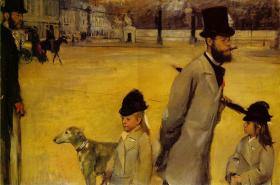Armstrong, Carol. Odd Man Out: Readings of the Work and Reputation of Edgar Degas. Chicago, IL and London: University of Chicago Press, 1991
Edgar Degas
Died: Paris, 27 September 1917
Nationality: French
bourgeois, banking family
with Louis Lamothe (1854); Ecoles des Beaux-Arts (1855-56)
1862 – meets Edouard Manet; begins association with the Impressionist artists
1865 – exhibits Misfortunes of the City of Orléans (Musée d’Orsay) at Paris Salon
1869 – begins making wax sculptures of horses; spends part of summer with Manet at Boulogne-sur-Mer
1870-71 – serves as National Guardsman during Franco-Prussian War
1873 – forms the Société Anonyme Coopérative des Artistes, Peintres, Sculpteurs, Graveurs (Anonymous Cooperative Society of Artists, Painters, Sculptors, Printmakers, known as the Impressionists) with Paul Cézanne, Claude Monet, Berthe Morisot, Camille Pissarro, and Alfred Sisley
1874 – exhibits Carriage at the Races at First Impressionist Exhibition
1876 – exhibits 24 works at the Second Impressionist exhibition
1877 – exhibits 25 works at the Third Impressionist exhibition
1879 – exhibits 20 works at the Fourth Impressionist exhibition
1880 – exhibits 12 works at the Fifth Impressionist exhibition
1881 – exhibits Fourteen Year Old Dancer at the Sixth Impressionist exhibition
1886 – exhibits in Eighth/last Impressionist exhibition; begins selling works through art dealers Durand-Ruel, Boussod & Valadon, Bernehim-Jeune, Hector Brame, and Ambroise Vollard
Travels
Rome (1856-58); Florence (1858-59; 1860); Siena and Pisa with Gustave Moreau (1859); Naples (1860); London (1871); New Orleans (1872)
Self-Portrait, 1855 (Musée d’Orsay, Paris)
Young Spartans Exercising, c. 1860 (The National Gallery, London)
Orchestra of the Opera, c. 1870 (Musée d’Orsay)
Carriage at the Races, c. 1872 (Museum of Fine Arts, Boston)
The Dance Class, 1873-76 (Musée d’Orsay)
Laundresses, 1884-86 (Musée d’Orsay)
Documentation:
Contemporary German painter Max Liebermann commented on Degas:
“The art of Degas is either naïve or so great that it appears to be naïve. He proudly despises any kind of virtuosity, any bragging of knowledge. His execution is timid and chaste. What he has to say, he says simply without unnecessary phrases. He works with the same artistic earnestness as Menzel, drawing indefatigably from Nature until he has found the characteristic pose. In the picture he gives an extract only, suppressing all that is unnecessary, always simplifying until nothing of the mere model is left. By no modern painter is literary interest so entirely eliminated as by Degas. To be truthful we must confess that sometimes the effect is unpleasant. There is nothing of the sympathy with which Rembrandt painted; on the contrary Degas seems to despise his models. In the half-grown ballet girl he shows already the future prostitute. He is like Nature, merciless, coldly skeptical. The foundation of his own nature is pride, and what he has of tender feelings he hides. He fears cynicism less than sentiment. From all this one sees that his Art is not ingratiating, but nevertheless we come under the spell of his colossal individuality. Whether or not that pleases us is a question of taste – or fashion.”
Max Liebermann and Adrian Stokes, “Degas,” The Artist: An Illustrated Monthly Record of Arts, Crafts and Industries, vol. 28 (August 1900): 118.
Degas’s English friend Walter Sickert recorded a statement made by Degas:
“I myself don’t like fiacres [horse-drawn taxis]. You don’t see anyone. That’s why I love the omnibus [horse-drawn bus]. You can watch people. One is created to look at people, isn’t one?”
Cited in Walter Sickert, “Degas,” The Burlington Magazine for Conoisseurs, vol. 31, no. 176 (November 1917): 191.
Eunice Lipton addresses accusations of misogeny on the part of Degas:
“The reluctance of art historians in our own century to reconsider this accusation of misogyny as a function of the social conventions and biases of Degas’s period is puzzling. But it may well result from the fact that these conventions and biases are ones that our own society to some extent still shares and endeavors to perpetuate.”
”Degas…played a notable and active role in encouraging women who were artists and in bringing them into the Impressionist circle. It was Degas who, after noticing and responding favorably to the work of Cassatt at the Salon of 1874, invited her, three years later, to exhibit with the Impressionists (which she did for the first time in 1879).”
“In portraiture, then, Degas did not paint women as stereotype feminine objects but as distinct human beings, emphasizing neither charm nor grace nor prettiness, but rather, individual character.”
“By interpreting Degas’s bachelorhood as a sure sign of serious maladjustment, we have been responding, clearly, to a cultural bias: we have been confusing what may simply have been a distaste for certain role-defined patterns of behavior and the kind of life they impose with distaste in general for all of the members of the opposite sex.”
Norma Broude, “Degas’s Misogyny,” The Art Bulletin, vol. 59, no. 1 (March 1977): 97, 102, 104, 107.




 Buy the Book
Buy the Book